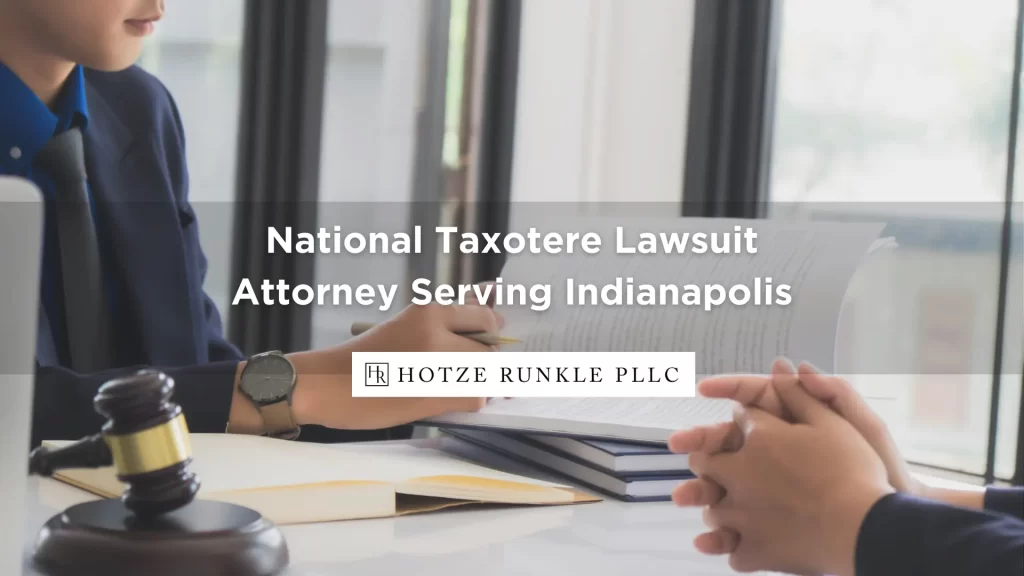
Taxotere was developed to treat different forms of cancer, such as breast cancer, neck cancer, prostate cancer, stomach cancer, and more. Taxotere is an effective cancer treatment. However, it’s manufacturer, Sanofi-Aventis, provided the drug to doctors and patients without disclosing the drug’s potential risks, such as the development of a serious, permanent eye condition called canalicular stenosis.
Some of the unusual symptoms associated with canalicular stenosis include excessive eye-watering, eyelid swelling, and blurry vision. These symptoms are debilitating and can significantly impact your life. You deserve to seek justice and financial compensation from Sanofi-Aventis for their careless actions.
If you’re suffering from the permanent, serious side effects of Taxotere, Hotze Runkle PLLC might be able to help you file a lawsuit against the drug company and hold them liable for the adverse reactions you’re experiencing. Take our quiz to learn about next steps.
Most Common Symptoms of Canalicular Stenosis
Most patients first notice symptoms during their chemotherapy regimen with Taxotere, or shortly following their chemotherapy treatment. The first side effect that usually develops is epiphora, or excessive eye-watering.
Normally, tears flow from the tear ducts through tubes called the canaliculi down into the nasal cavity. Taxotere, however, can cause the canaliculi to become inflamed. When inflammation occurs, the canaliculi can begin to close and block tears from traveling through to the nasal ducts, as they normally would.
Without immediate medical care, the symptoms can worsen and lead to a medical condition known as canalicular stenosis.
Canalicular stenosis develops when inflammation of the canaliculi turns into a permanent obstruction. When you have canalicular stenosis, tears can’t travel to the nasal cavity. Instead, they build up on the surface of the eye and roll down the patient’s cheeks. Unfortunately, there is no known cure.
The most common symptoms include:
- Excessive watery eyes
- Sensitivity to light
- Dry eyes
- Swollen eyelids
- Clouded eye lens
- Central vision loss
- Blurry vision
- Headaches
- Infections
Everyone is different and experiences varying degrees of symptoms when they develop canalicular stenosis. For some, it’s only a minor nuisance, while others are unable to complete routine tasks. It can diminish quality of life and prevent someone from maintaining employment or supporting their family.
The Link Between Taxotere and Tears
Your oncologist will recommend a specific Taxotere regimen depending on the type of cancer you have and its stage. You can receive the treatment orally or intravenously once a week, every other week, or once every three weeks. Unfortunately, medical studies uncovered a dangerous link between a patient’s tears and the chemo drug.
When Taxotere travels through the body, it comes in contact with different bodily fluids, such as tears. Those tears can then cause inflammation of the canaliculus, and an infection can form. If the inflammation and infection aren’t immediately treated, the damage can become so severe that the eye structures start closing, which can lead to canalicular stenosis.
Is There a Cure for Canalicular Stenosis?
Unfortunately, it isn’t a curable medical condition. There are options to treat your symptoms and prevent them from getting worse, but there are risks. If you want to discuss the available medical options, contact an ophthalmologist to determine if surgery, such as dacryocystorhinostomy (DCR), is right for you.
During DCR, the doctor uses structures near the eye to create a new tunnel for tears to flow into the nasal cavity. In some situations, they can use a stent and place it over the obstructed canaliculus.
Unfortunately, not everyone is eligible for this particular surgery. If one or both canaliculi are severely damaged, conjunctivodacryocystorhinostomy (CDCR) might be necessary. CDCR requires the surgeon to use a small glass tube as the passageway to redirect tears around the damaged canaliculus.
How to Hold Sanofi-Aventis Liable
 For years, no one knew about the risks they were taking when using Taxotere as their chemo drug. Doctors weren’t aware of the adverse reactions, either. They recommended the treatment to patients, not realizing the harm it could cause.
For years, no one knew about the risks they were taking when using Taxotere as their chemo drug. Doctors weren’t aware of the adverse reactions, either. They recommended the treatment to patients, not realizing the harm it could cause.
Sanofi-Aventis was negligent in not providing adequate warning labels or notifying the U.S. Food and Drug Administration about the severe side effects of their drug.
Negligence is a legal theory often used in product liability cases like yours. It refers to an incident where one person owes another a duty to prevent them from harm and fails in that duty. When you file a lawsuit, you can use this theory as the basis of your case. You must prove five elements existed to show the drug company was negligent:
- Sanofi-Aventis owed you a duty of care;
- They breached their duty;
- If it wasn’t for their breach, you wouldn’t have sustained injuries;
- Their actions were the direct cause of your symptoms; and
- You suffered losses.
Whether you completed a chemo regimen with Taxotere or are still receiving treatment, you may have the right to sue Sanofi-Aventis for compensation. There’s a deadline known as a statute of limitations you have to comply with if you want to seek legal action. The statute of limitations for product liability cases in Indiana is two years. That means you have two years from the date of your injury to file suit, or you’ll lose your right to pursue compensation.
Speak to An Experienced Indianapolis Taxotere Canalicular Stenosis Lawyer
Hotze Runkle PLLC knows the importance of receiving a fair monetary award for the suffering you endured. You trusted that Taxotere would treat your cancer without causing harmful symptoms. Unfortunately, Sanofi-Aventis took advantage of that trust. They placed profits over the safety of patients throughout the country.
When you hire us, we will work diligently to prove negligence and hold the manufacturer responsible. Since 2007, we have helped our clients pursue the maximum available compensation and recover from their traumatic experiences. You won’t be alone in this fight for justice. We will stay by your side from start to finish of your case.
At Hotze Runkle PLLC, we understand the financial burden you’re already facing. Medical treatment is costly, especially if you require ongoing care for a permanent condition. We don’t want to add more expenses to your plate, which is why we take cases on contingency. We don’t charge upfront fees or costs to represent our clients. If you don’t get paid, we don’t get paid.
If a doctor diagnosed you with canalicular stenosis, take our Taxotere quiz to find out if you’re eligible to file a lawsuit.